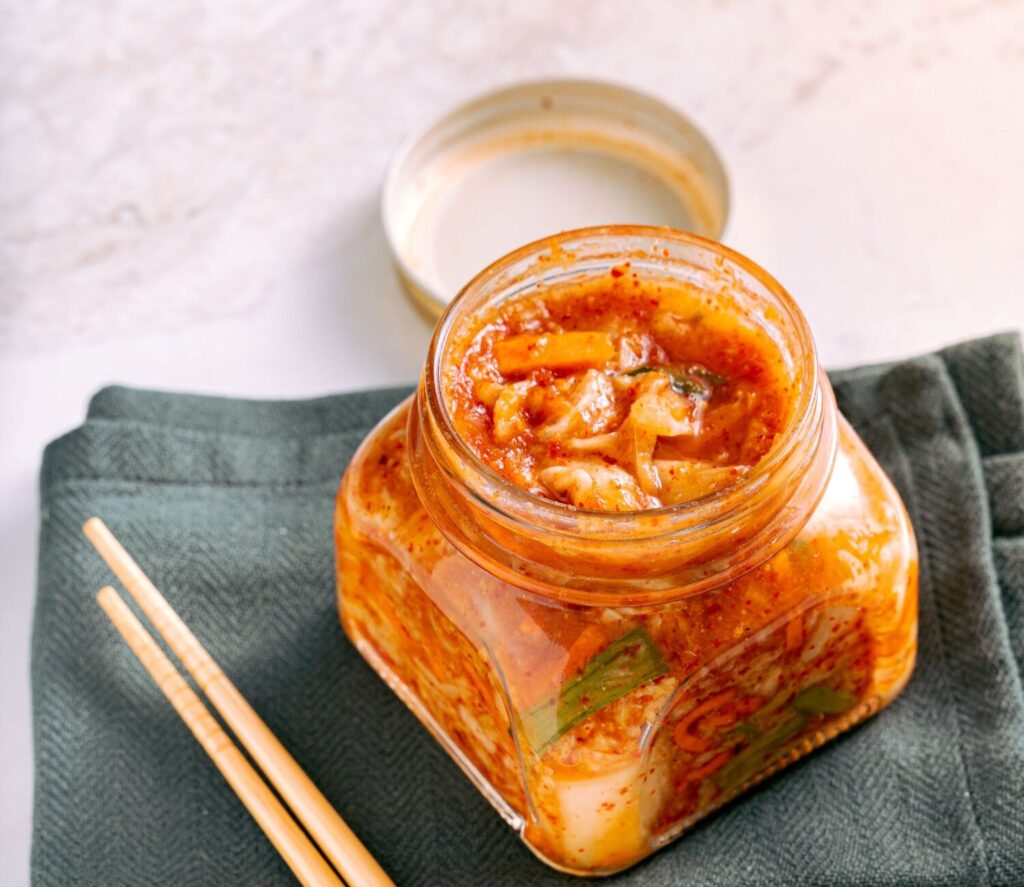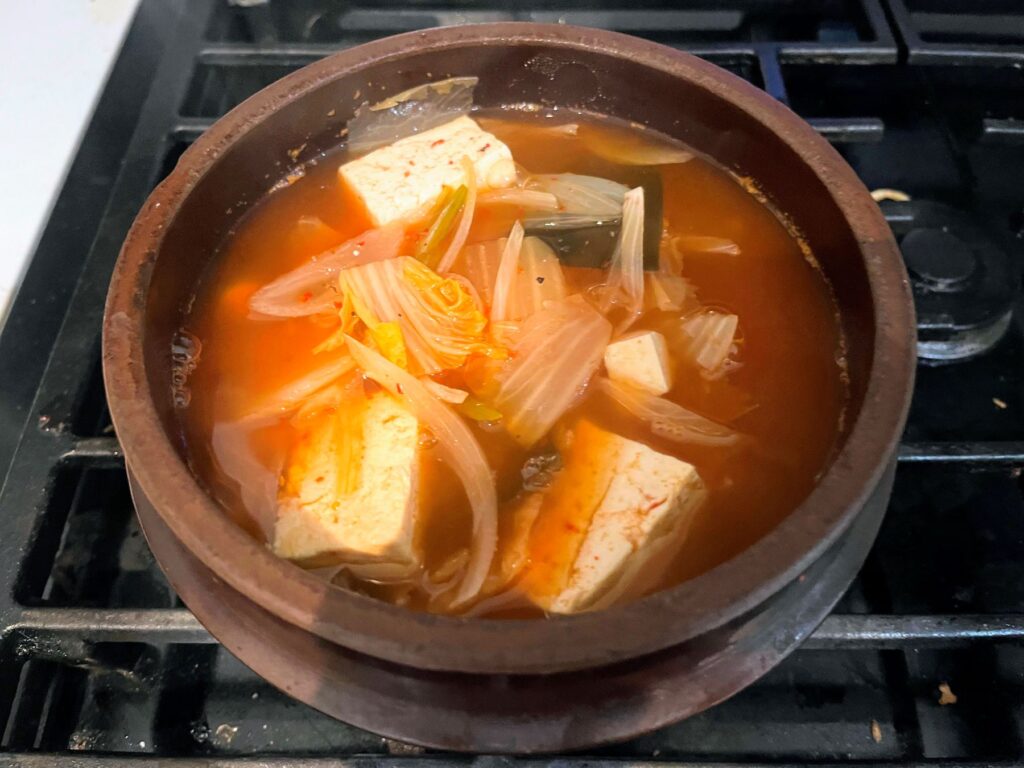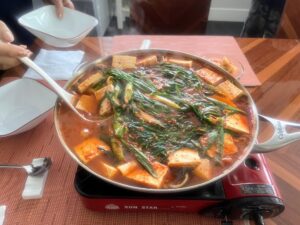Kimchi soup, also known as kimchi guk, is a popular Korean dish that’s both comforting and packed with flavor. It’s made with fermented kimchi, which gives the soup its bold and tangy taste, along with other simple, healthy ingredients. This soup is not only easy to make but also a great way to use up leftover kimchi. Whether you’re new to Korean cooking or a kimchi lover, this recipe is perfect for a warm and satisfying meal. Let’s dive into making this delicious Korean kimchi soup!
The History of Korean Kimchi Guk
Kimchi guk, or kimchi soup, has been a beloved part of Korean cuisine for centuries. It originated as a simple and resourceful dish made to use older, fermented kimchi during the long winters.
Kimchi, a staple in Korean households, was traditionally prepared in large quantities during kimjang, the annual kimchi-making season. Families relied on this fermented vegetable as a key ingredient in various meals. Kimchi guk became a quick and nutritious way to enjoy its bold and tangy flavors.
Over time, kimchi guk evolved with the addition of ingredients like anchovy broth, tofu, or vegetables, depending on what was available. The soup remains a comforting and practical dish. It reflects the values of Korean culture, such as minimizing waste and making the most of seasonal ingredients.
Today, kimchi guk is loved around the world for its simplicity, unique taste, and deep connection to Korean traditions.
Many Health Benefits

Korean kimchi soup is not only delicious but also packed with health benefits. The main ingredient, kimchi, is rich in probiotics, which support gut health and improve digestion.
These probiotics can help strengthen the immune system and promote a healthy balance of bacteria in the body. Additionally, kimchi contains vitamins A, B, and C, along with antioxidants that fight inflammation and protect against disease.
Kimchi soup is also low in calories and high in nutrients, making it a great choice for those looking to maintain a healthy diet. Ingredients like tofu, vegetables, and broth add protein, fiber, and hydration to the meal.
The spicy kick from kimchi can also boost metabolism, aiding in weight management. Overall, kimchi soup is a wholesome dish that nourishes the body while delivering bold flavors.
Tips for Making Kimchi Soup
When making kimchi soup, the type of kimchi you use makes a difference. Over-fermented cabbage kimchi is perfect for this dish because it has a stronger, tangy flavor that adds depth to the soup. Fresh kimchi can work too, but it won’t give you the same rich taste. If you have older kimchi sitting in your fridge, this recipe is the best way to use it up.
I love adding mushrooms to my kimchi soup because they bring an earthy flavor and extra texture. Any type of mushroom works, so feel free to choose your favorite if you’re a mushroom lover like me. They make the soup heartier and even more delicious.
For the broth, I recommend using anchovy broth for its savory and traditional taste. If you’re vegan, Korean soybean sprouts are a great alternative. They add a light, refreshing flavor to the soup and can be easily found at most Asian markets. Whether you choose anchovy broth or soybean sprouts, the result will be a flavorful and satisfying kimchi soup.
Simple Korean Kimchi Soup Recipe

Ingredients:
- 1 cup chopped kimchi
- 1/2 onion, thinly sliced
- 2 cloves garlic, minced
- 1/2 tablespoon gochugaru (Korean red pepper flakes)
- 1 Tbs of soy bean paste (optional)
- 4-5 cups Korean vegetable broth or water
- 1 cup cubed firm tofu
- 2 green onions, chopped
- 1/2 cup of Mushrooms of your choice (optional)
- Salt to taste
- Few soup Anchovies or Soybean Sprouts (optional)
Instructions:
Prepare the Base
In a pot, combine Korean vegetable broth and soybean paste. If you’re using anchovies, add them at this stage. For soybean sprouts, add them later with the kimchi. Bring the mixture to a boil, then reduce the heat to medium and let it simmer for 5-10 minutes to create a flavorful base for your kimchi soup.Add Key Ingredients
Stir in the main ingredients, including kimchi, minced garlic, gochugaru (Korean red pepper flakes), onion, and soybean sprouts if you are using them. Then, let the soup cook for another 3 to 5 minutes to allow the flavors to blend.Enhance with Mushrooms
If you’re using mushrooms, add them to the boiling soup. Let the soup simmer for an additional 5 minutes to deepen the flavor with the earthy taste of mushrooms.Finish with Tofu and Green Onions
Gently add tofu and green onions to the simmering soup. Let it cook for another 5-10 minutes. Adjust the seasoning with salt or extra soybean paste to suit your taste.Serve and Enjoy
Ladle the hot kimchi soup into a bowl and serve it with steamed rice on the side for a hearty and satisfying meal.
Perfect Meal Pairing Idea
Korean kimchi soup is a comforting and healthy meal that’s easy to make and enjoy. One of my favorite ways to eat it is by pairing it with roasted seaweed. Wrapping steamed rice in seaweed sheets and enjoying it alongside the soup creates a delicious balance of textures and tastes.
Whether you’re making it with anchovy broth or soybean sprouts, this dish is a perfect way to enjoy the bold and tangy flavors of kimchi while warming up with a hearty meal. Give it a try and discover your favorite way to enjoy this classic Korean soup!
Be sure to check out my post on how to make delicious kimchi fried rice using fermented cabbage kimchi. Don’t miss my favorite easy recipe for radish kimchi too—it’s a must-try!














